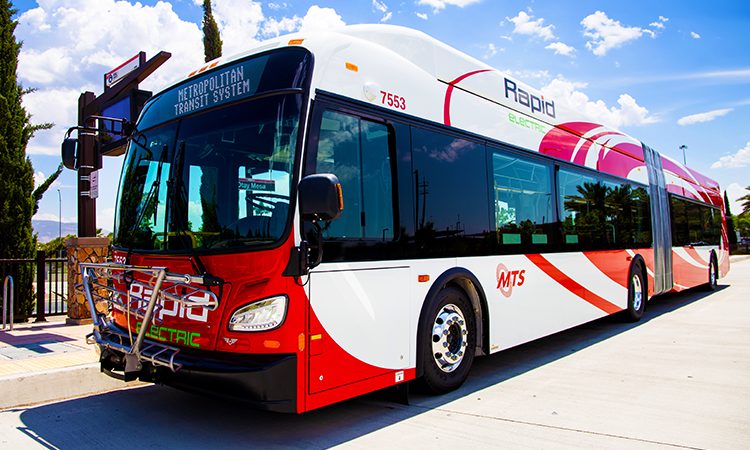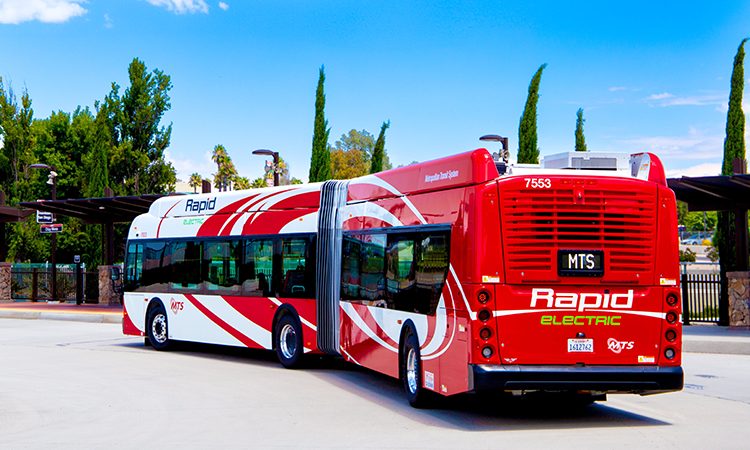On the road to tomorrow: Transforming San Diego’s transit landscape with zero-emission buses
- Like
- Digg
- Del
- Tumblr
- VKontakte
- Buffer
- Love This
- Odnoklassniki
- Meneame
- Blogger
- Amazon
- Yahoo Mail
- Gmail
- AOL
- Newsvine
- HackerNews
- Evernote
- MySpace
- Mail.ru
- Viadeo
- Line
- Comments
- Yummly
- SMS
- Viber
- Telegram
- Subscribe
- Skype
- Facebook Messenger
- Kakao
- LiveJournal
- Yammer
- Edgar
- Fintel
- Mix
- Instapaper
- Copy Link
Posted: 28 November 2023 | Sharon Cooney - San Diego Metropolitan Transit System | No comments yet
Sharon Cooney, Chief Executive Officer of the San Diego Metropolitan Transit System, provides insight into the agency’s ambitious journey toward a zero-emission bus fleet, emphasising the transformative commitment to community wellbeing and sustainability, as well as the challenges faced in navigating the transition.


Credit: San Diego MTS - Rapid 227 is the agency’s first route with dedicated electric buses and a significant milestone in it’s transition to an all zero-emissions bus fleet by 2040.
Innovation in the transit industry is no small task. Making major changes to the way that we do business is often difficult and can take years – or decades – to plan and execute. The San Diego Metropolitan Transit System (MTS) – along with other transit systems across California – is embarking on another major change: transitioning from a natural gas-powered bus fleet to an all zero-emission bus fleet by 2040.
Our agency built and operated the first modern light rail system in the U.S… which began service in 1981. This was our first step into the world of creating an all-electric transit fleet”
MTS is no stranger to innovation. Our agency built and operated the first modern light rail system in the U.S., the San Diego Trolley, which began service in 1981. This was our first step into the world of creating an all-electric transit fleet, producing zero tailpipe emissions. Now, 42 years later, our new task is transitioning the entire bus fleet to zero-emission.
We’ve been on this transition path for some time. First, it was the transition from diesel buses to compressed natural gas (CNG). This effort began in 1994, and we finally retired the last diesel fuelled bus in 2021. These innovative transitions take time, and it takes many stakeholders to accomplish.
With the help of industry leaders like Gillig, El Dorado, New Flyer and MCI, MTS was able to phase in CNG buses over the last 27 years. This conversion was led by a vision of sustainability, as CNG buses offer a 100% reduction in particulate matter, and a 98% reduction in NOx emissions over diesel buses. As time passed and the call for new innovation was heard, this same approach was used to determine what was next for MTS, leading to MTS’ zero-emission bus (ZEB) pilot programme.
Navigating the path to sustainability through innovative programmes
A major milestone in our early efforts transitioning to a zero-emission fleet is the Rapid 227. This new bus route is the first route with dedicated electric buses in our history”
Ever since the MTS Board of Directors unanimously approved the ZEB pilot programme in 2017, MTS has spearheaded an agency-wide effort to comply with the California Air Resources Board’s (CARB) Innovative Clean Transit (ICT) rule. The ICT rule requires that all California public transit agencies transition to ZEB vehicles and technologies by 2040 to help the State of California to reach its climate action goals. For MTS, this meant gradually transitioning our entire bus fleet from CNG to ZEB, which, although similar in nature to the previous conversion of buses, proved to be a transformative endeavour for the agency.
As part of this pilot programme, MTS has made critical partnerships with organisations such as the Center for Transportation and the Environment (CTE), which has helped the agency to formulate our design and requirements of the ZEB programme, as well as identifying benefits and challenges.
A major milestone in our early efforts in transitioning to a zero-emission fleet is the Rapid 227. This new bus route is the first route with dedicated electric buses in our history and features 12 60ft articulated battery electric buses. Rapid 227 offers higher frequencies, longer spans of service and better amenities than standard routes. It is situated in a key corridor that suffers from significant air pollution along the U.S.–Mexico port of entry in Otay Mesa, so the battery electric buses reduce local carbon emissions in an area that significantly needs it. This initiative has also enabled MTS to begin incorporating new state-of-the-art overhead electric bus charging infrastructure at our nearby bus division. Our plan is to learn from building this infrastructure at the first location and then replicating the infrastructure at our four other bus divisions.


Credit: San Diego MTS
Tackling the challenges
To complete our transition by 2040, MTS will need to build an entirely new bus division dedicated solely to ZEBs and increase the size of our fleet”
Among the biggest challenges of converting and phasing in a transformative programme, such as the ZEB pilot, was the cost of building the infrastructure and the procurement of new battery electric buses (BEBs). For example, there is currently an industry premium of $400,000 to order BEBs, making the conversion to this technology an expensive one. Besides the operating costs, there are also other challenges, such as the range of travel (the average range for ZEBs is 140 miles, while a CNG bus range is up to 500 miles) and redundancy.
With new technologies, there will always be operational concerns to consider, such as the lack of a ‘1-to-1’ replacement between ZEB and CNG buses. As ZEBs have less than half the range of their natural gas-powered counterparts, more (expensive) buses are needed. To complete our transition by 2040, MTS will need to build an entirely new bus division dedicated solely to ZEBs and increase the size of our fleet. Being so heavily invested in electric power also adds the challenge of being prepared for power outage, which would prevent the use of these buses all together. These challenges are ones that we will continue to study and improve as our teams adjusts to the new technology.
Looking at the bigger picture
Our priority will always be our riders during this transition”
While pricey and many unknowns lie ahead with the 2040 transition, the benefits are clear. This transition provides a tangible example for San Diego residents of how riding transit can benefit not just those who ride it, but also the community as a whole. From Rapid 227 to further instalments of ZEB vehicles along the MTS system, we are committed to this stage of innovation and greener projects that benefit our riders and the communities that we serve. Our priority will always be our riders during this transition.
This growth of our transit system is no small task. But we intend to stay true to this commitment with community partnerships, communicating with regional stakeholders and staying connected with local, state and federal officials to help us to sustain this momentum and meet our 2040 goal. Most importantly, it takes a strong commitment from our employees at MTS. From our Planning Department to our Bus Operation team and throughout the agency, this transition requires a team effort with one goal in mind, to continue providing exceptional service for the communities that we serve.


Related topics
Air Quality, Alternative Power, Passenger Experience, Public Transport, Sustainable Urban Transport
Related modes
Bus & Coach
Related cities
San Diego
Related countries
United States
Related organisations
San Diego Metropolitan Transportation System (MTS)
Related people
Sharon Cooney







